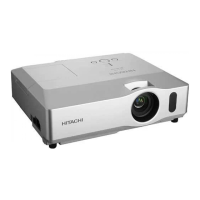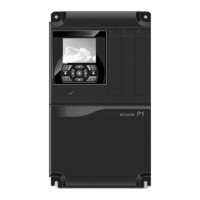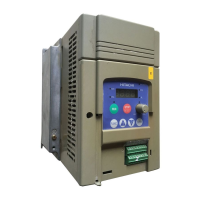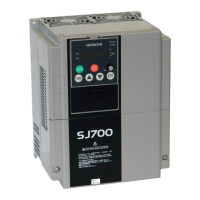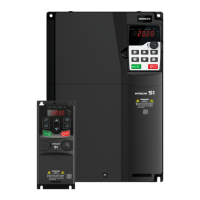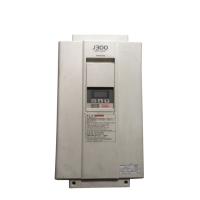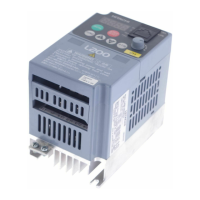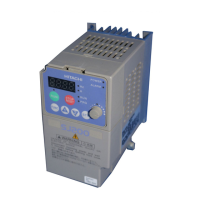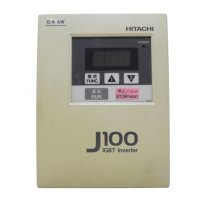Do you have a question about the Hitachi X200 Series and is the answer not in the manual?
Details high voltage hazards and safety precautions when servicing.
Provides essential safety warnings and cautions for installation and operation.
Specifies wire types, equipment ratings, and circuit protection requirements.
Emphasizes safety for wiring work: grounding, qualified personnel, power OFF, and proper mounting.
Lists critical cautions for heat sinks, operational limits, frequencies, and powerup checks.
Warns about setting B012 to motor FLA rating for overload protection.
Covers safe operation practices, restart risks, and emergency stop requirements.
Warns about touching energized parts, conductive objects, and risks of automatic start.
Covers Stop Key functionality and the need for a separate emergency stop switch.
Covers safety for maintenance, handling components, and troubleshooting electrical aspects.
Summarizes UL warnings for troubleshooting, wire types, and circuit protection.
Lists UL warnings regarding pollution, temperature, capacitor discharge, overload, and short circuit protection.
Provides tables for terminal tightening torque and wire size ranges for field wiring.
Lists UL-listed inverse time circuit breakers and fuses with their ratings for inverter input power.
Explains the solid-state motor overload protection using parameters B012 and B212.
Warns that electronic overload protection does not support multiple motors; use external thermal relay.
Details the main features and performance characteristics of the X200 inverter.
Provides detailed specifications for 200V and 400V class X200 inverter models.
Lists detailed specifications for 200V class X200 inverter models, including current, voltage, and weight.
Provides detailed specifications for 400V class X200 inverter models, including current, voltage, and weight.
Details parameters for setting basic frequency profile, acceleration, and deceleration times.
Details steps for accessing power input and motor output terminals, including removing housing partitions.
Outlines the basic installation steps from choosing a location to making observations.
Specifies clearance dimensions around the inverter for adequate ventilation and cooling.
Emphasizes reviewing cautions and warnings before proceeding with wiring steps.
Provides tables for determining wire sizes (AWG) and applicable equipment fuses (UL-rated).
Lists terminal screw dimensions and specified tightening torques for safe wiring connections.
Guides on connecting power input wiring, noting terminal assignments and examples.
Instructs on connecting motor output terminals and chassis ground, with wiring guidelines.
Provides instructions and warnings applicable to powerup tests and general inverter operation.
Details high voltage hazards and safety precautions when servicing.
Provides essential safety warnings and cautions for installation and operation.
Specifies wire types, equipment ratings, and circuit protection requirements.
Emphasizes safety for wiring work: grounding, qualified personnel, power OFF, and proper mounting.
Lists critical cautions for heat sinks, operational limits, frequencies, and powerup checks.
Warns about setting B012 to motor FLA rating for overload protection.
Covers safe operation practices, restart risks, and emergency stop requirements.
Warns about touching energized parts, conductive objects, and risks of automatic start.
Covers Stop Key functionality and the need for a separate emergency stop switch.
Covers safety for maintenance, handling components, and troubleshooting electrical aspects.
Summarizes UL warnings for troubleshooting, wire types, and circuit protection.
Lists UL warnings regarding pollution, temperature, capacitor discharge, overload, and short circuit protection.
Provides tables for terminal tightening torque and wire size ranges for field wiring.
Lists UL-listed inverse time circuit breakers and fuses with their ratings for inverter input power.
Explains the solid-state motor overload protection using parameters B012 and B212.
Warns that electronic overload protection does not support multiple motors; use external thermal relay.
Details the main features and performance characteristics of the X200 inverter.
Provides detailed specifications for 200V and 400V class X200 inverter models.
Lists detailed specifications for 200V class X200 inverter models, including current, voltage, and weight.
Provides detailed specifications for 400V class X200 inverter models, including current, voltage, and weight.
Details parameters for setting basic frequency profile, acceleration, and deceleration times.
Details steps for accessing power input and motor output terminals, including removing housing partitions.
Outlines the basic installation steps from choosing a location to making observations.
Specifies clearance dimensions around the inverter for adequate ventilation and cooling.
Emphasizes reviewing cautions and warnings before proceeding with wiring steps.
Provides tables for determining wire sizes (AWG) and applicable equipment fuses (UL-rated).
Lists terminal screw dimensions and specified tightening torques for safe wiring connections.
Guides on connecting power input wiring, noting terminal assignments and examples.
Instructs on connecting motor output terminals and chassis ground, with wiring guidelines.
Provides instructions and warnings applicable to powerup tests and general inverter operation.
| Series | X200 |
|---|---|
| Output Frequency | 0-400 Hz |
| Cooling Method | Fan Cooled |
| Type | Inverter |
| Control Method | V/F control |
| Overload Capacity | 150% for 60 seconds |
| Braking Unit | Built-in |
| Communication | RS485, Modbus RTU |
| Protection Features | Overcurrent, Overvoltage, Undervoltage, Overheating, Short Circuit |
| Ambient Temperature | -10°C to +50°C |
| Humidity | 5 to 95% RH (Non-condensing) |
| Enclosure Rating | IP20 |
| Operating Temperature | -10°C to +40°C |
| Storage Temperature | -20°C to +60°C |
